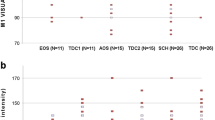Abstract
Many reports can be found in the theoretical literature that refer to a lack of self-awareness or a failure to distinguish self from nonself as a characteristic of autistic children. The empirical literature also contains reports of behaviors in autistic children that have often been taken as reflective of a failure to differentiate self, i.e., pronominal reversal, gaze aversion. The present study investigated the development of self-recognition in 15 autistic children in an effort to determine whether failures of self-recognition were of possible diagnostic significance for the syndrome or rather were reducible to general indices of developmental function, i.e., mental age. Fifty-three percent of the sample showed clear self-recognition. On the basis of a developmental assessment and data from a teacher questionnaire, these children were found to be functioning at mental ages akin to developmental norms for self-recognition. Those who failed to show self-recognition had mental ages below the developmental level at which many children recognize themselves and significantly lower than those autistic children who showed self-recognition. The results suggest that even when autistic children fail to recognize their self-images, this failure can be taken not as evidence for a syndrome-specific deficit but as a reflection of a general developmental delay.
Similar content being viewed by others
Reference
American Psychiatric Association.Diagnostic and statistical manual of mental disorders (3rd ed.). Washington, D. C.: Author, 1980.
Amsterdam, B. Mirror self-image reactions before age two.Developmental Psychobiology, 1972,5, 297–305.
Amsterdam, B., & Greenberg, L. M. Self-conscious behavior of infants: A videotape study.Development Psychobiology, 1977,10, 1–6.
Anthony, E. J. Classification and categorization in child psychiatry.International Journal of Psychiatry, 1967,3, 173–178.
Beller, E. K.Clinical process: A new approach to the organization and assessment of clinical data. Glencoe, Illinois: Free Press, 1962.
Bertenthal, B. I., & Fischer, K. W. The development of Self-conscious behavior of infants: A videotape study.Developmental Psychology, 1978,14, 44–50.
Bettelheim, B.The empty fortress: Infantile autism and the birth of the self. New York: Free Press, 1967.
Creak, M. Schizophrenic syndrome in childhood: A report of the working party.British Medical Journal, 1961,2, 889–890.
Fay, W. H. Personal pronouns and the autistic child.Journal of Autism and Developmental Disorders, 1979,9, 247–260.
Ferrari, M. Childhood autism: Deficits of communication and symbolic development. I. Distinctions from language disorders.Journal of Communication Disorders, 1982,15, 191–208.
Goldfarb, W. Childhood psychosis. In P. Mussen (Ed.),Carmichael's manual of child psychology, II. New York: Wiley, 1970.
Group for the Advancement of Psychiatry. Psychopathological disorders in childhood: Theoretical considerations and a proposed classification.GAP Report, 1966,6(62), 173–343.
Hutt, C., & Ounsted, C. The biological significance of gaze aversion with particular reference to the syndrome of infantile autism.Behavioral Science, 1966,11, 346–356.
Lewis, M., & Brooks, J. Self knowledge and emotional development. In M. Lewis & L. Rosenblum (Eds.),The development of affect. New York: Plenum, 1978, Pp. 205–226.
Lewis, M., & Brooks-Gunn, J.Social cognition and the acquisition of self. New York: Plenum Press, 1979.
Mahler, M. On childhood psychosis and schizophrenia: Autistic and symbiotic infantile psychosis.Psychoanalytic Study of the Child, 1952,7, 286–305.
Mans, L., Cicchetti, D., & Sroufe, L. A. Mirror reactions of Down's syndrome infants and toddlers: Cognitive underpinnings of self-recognition.Child Development, 1978,49, 1247–1250.
National Society for Autistic Children. National Society for Autistic Children definition of the syndrome of autism.Journal of Autism and Childhood Schizophrenia, 1978,8, 162–167.
Ornitz, E. M., & Ritvo, E. R. Neurophysiologic mechanisms underlying perceptual inconstancy in autistic and schizophrenic children.Archives of General Psychiatry, 1968,19, 22–27.
Ornitz, E. M., & Ritvo, E. R. The syndrome of autism: A critical review.American Journal of Psychiatry, 1976,133.
Prior, M. R. Cognitive abilities and disabilities in infantile autism.Journal of Abnormal Child Psychology, 1979,7, 357–380.
Author information
Authors and Affiliations
Rights and permissions
About this article
Cite this article
Ferrari, M., Matthews, W.S. Self-recognition deficits in autism: Syndrome-specific or general developmental delay?. J Autism Dev Disord 13, 317–324 (1983). https://doi.org/10.1007/BF01531569
Issue Date:
DOI: https://doi.org/10.1007/BF01531569




